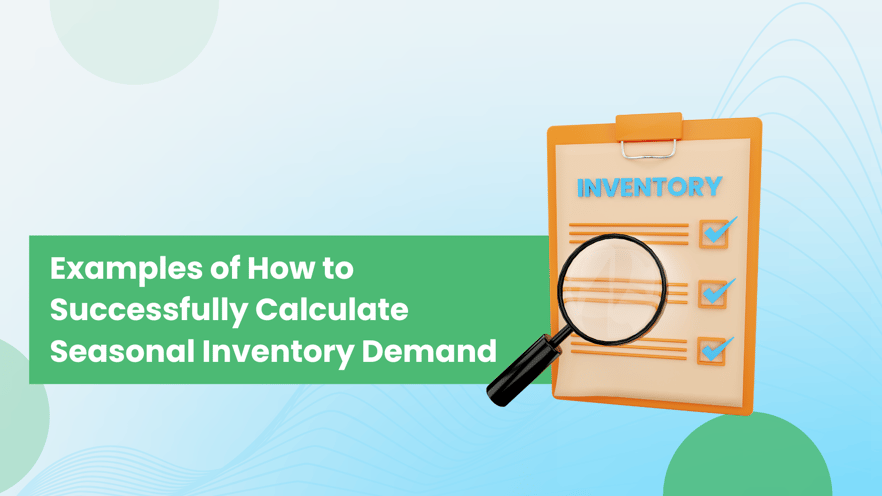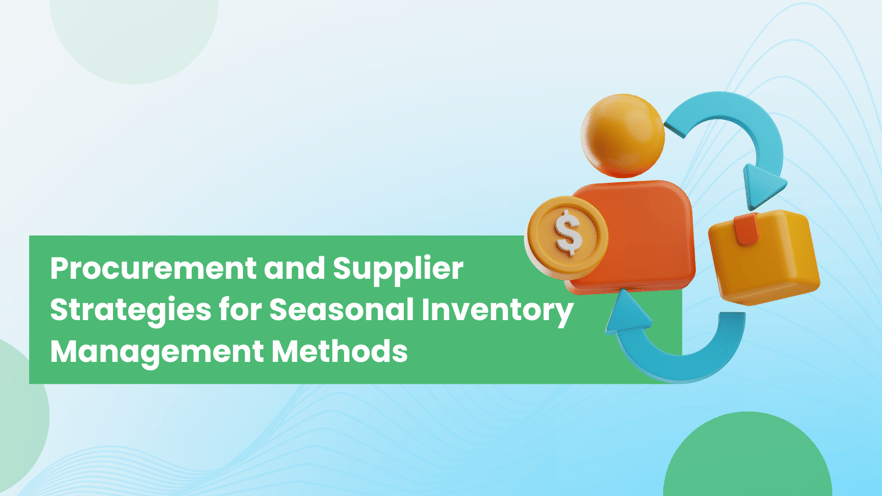Effective Tips to Manage Seasonal Inventory to Meet Seasonal Demand Fluctuations
Increase Sales and Inventory Optimization with Time-Bound SKU Strategies
Ramp up your sales and get your inventory in tip-top shape by using time-based strategies for your product offerings.
Time-Bound SKUs - Get Those Sales Up by Using Effective Seasonal Demand Forecasting

In the world of retail, time is a carousel that brings different products to the front with each new season.
Time-bound SKUs, or stock-keeping units, are the key players in the carousel of managing seasonal inventory, effectively dealing with yearly fluctuations in demand. Unlike their evergreen counterparts, which are the mainstays of retail all year, time-bound SKUs have a limited time.
As the spotlight shines on them for a season or holiday time, these products face a ticking clock; their importance fades as fast as it peaked, and they must make their mark before the carousel turns again.
These seasonal stars, ranging from back-to-school supplies to holiday decorations, create a unique dance of demand, where understanding the rhythm can be the difference between a hit product and a warehouse filled with old news.
The balance of keeping just enough inventory to meet the demand, without being left with excess that becomes financial baggage, is a tightrope walk that needs precision.
The main benefit of using the potential of time-bound SKUs is their power to align with customer demand.
By capturing the essence of a season, these products connect with buyers and create a link that drives sales.
They have the potential to revitalize sales figures throughout the year and enable retailers to differentiate themselves in an overcrowded marketplace with improved inventory management software.
Key Concepts and Benefits - The True Power of Effective Demand Forecasting
Imagine a retailer carefully selecting a range of swimwear for the summer season keeping in mind the supply chain and the need to manage seasonal inventory.
These products serve as time-bound SKUs, which essentially translate to having a short shelf life dictated by the fluctuations in seasonal demand forecasting.
Once Labor Day has come and gone, demands for beach attire dwindle like the daylight hours of autumn. Inventory management software helps to predict these seasonal changes in demand.
The magic of time-bound SKUs is that they offer a focused chance to capture seasonal sales, where timing and relevance rule.
These SKUs offer strategic advantages in managing seasonal inventory, too.
Retailers can align with growing consumer desires and ride the wave of seasonal excitement.
These items carry the potential not only for significant profit margins during their peak season but also for creating a buzz that draws shoppers into stores or online platforms, where they might stay to shop for more.
Examples of How to Successfully Calculate Seasonal Inventory Demand

Take, for example, a fictional apparel retailer, "Vogue Vista." They specialize in holiday-themed garments and understand the art of seasonal timing.
Adopting a time-bound SKU strategy, Vogue Vista introduces an exclusive line of Halloween costumes starting in early September. They create buzz and anticipation, align inventory with peak demand, and by November, transition seamlessly to cozy, winter holiday-themed attire.
By predictively managing the Halloween inventory through strategic discounts with inventory management software, they optimize storage space for the next seasonal items, mitigating supply chain disruptions.
In another instance, "Gizmo Gadgets," a consumer electronics store, anticipates the annual tech rush leading up to the back-to-school season.
They focus on time-bound SKUs such as the latest graphing calculators and trendy laptop accessories.
Through meticulous demand forecasting and savvy marketing, they cater to the student demographic, ensuring they have just the right amount of stock at precisely the right time, avoiding the dreaded stockout or the burdensome overstock scenario.
The success of these examples isn't hinged on chance; it's about employing the best seasonal inventory management practices considering product life cycles, market trends, and consumer behavior.
As these retailers navigate the shifting sands of seasonality, they place their bets on the time-bound SKUs that promise a harvest of profits aligned with the ebb and flow of consumer demand.
Make Sure You've Got Just the Right Amount of Stuff in Stock by Using Time-Based Methods for Organizing Your Products
When dealing with time-bound SKUs, tactical planning is the secret sauce that ensures your seasonal items hit the mark.
Think of it like getting ready for a big holiday dinner. You need to improve your seasonal inventory management; know who's coming (forecasting demand), what to cook (selecting the right products), and make sure everything is ready when guests arrive (manage your inventory).
What is Seasonal Demand Forecasting and Useful Methods for Seasonal Items Management
Forecasting seasonal demand for items and maintaining the appropriate amount of inventory is a mix of educated guessing and solid number-crunching.
You've got to blend what you feel in your gut about customer wants (qualitative methods) with hard data from past sales (quantitative methods) to effectively manage your seasonal inventory levels.
Historical sales data are gold mines that help build forecasting models. They give clues on how much of a seasonal item sold in the past and they are the starting point for predicting future sales.
But to avoid being thrown off by the winds of change, you also need to factor in new trends.
This is where techniques for boosting accuracy step in. Inventory management software fine-tunes your predictions to better match what your customers will likely be after due to seasonal changes.
Procurement and Supplier Strategies for Seasonal Inventory Management Methods

Getting your stock just right for the season, due to seasonal changes in demand, is like setting the table for that holiday dinner.
You need to work closely with your suppliers, like making sure they can handle last-minute changes to your menu.
Renegotiating contracts for more adaptability allows for adjustments in orders depending on inventory turnover and demand trends.
You'll avoid being stuck with a bunch of unsold stock when the season's over, just like you wouldn't want a ton of leftover food.
Strategic ordering and perfect timing ensure your inventory arrives fresh, right as the season kicks off.
You aim to have these products ready for high demand, not gathering dust due to seasonal changes.
Inventory Positioning Tactics - Top Challenges of Seasonal Demand Forecasting
Positioning your inventory is about having the right products in the right places at the right times.
Think about where to store your seasonal inventory so they can quickly get to your customers when demand starts to surge.
You also need to maintain adequate safety stock to accommodate those unexpected spikes in demand.
But be careful not to overdo it and end up with a surplus that nobody wants later on.
Boost Sales and Streamline Inventory Management With Time-Based SKU Strategies to Minimize Surplus and Prevent Stockouts
At the end of the season, use your inventory management software to get creative with managing your remaining inventory.
Markdowns, promotions, and clearance sales are your tools to help clear out the last of the stock.
It's your final push to sell through the leftovers, turning what could be a loss into a chance to give your customers some amazing deals.
Throughout the season, keep a close eye on your stock levels using inventory management software.
This way, managing your seasonal inventory ensures you're not overbuying, and you can act fast to sell off any surplus in response to changes in demand.
Managing time-bound SKUs effectively means finding the right balance - having enough safety stock to meet increased demand but not so much that you're left with a stack of unsold items.
It's about being proactive and using smart strategies to ensure everything sells by the time the season changes.
Leveraging Data Analytics
Running a retail business with seasonal products is a bit like being a detective.
You've got to spot the patterns, find the clues, and predict what will happen next.
Data analytics is your magnifying glass here - it highlights the minute, important details helping you make better inventory control decisions for your seasonal items.
Analytics Approaches for Seasonal Items

When each seasonal product is like a piece of a puzzle, SKU-level analysis is how you figure out where each piece goes.
It's all about delving deep into the specifics of each product, understanding its previous sales history, and using this information for your next inventory planning move.
Consider the dashboard as your command center in the seasonal inventory management system. It pulls together all the important stuff:
- How much you're buying
- How much you're selling can be accurately reported with inventory management software.
- What you've got left in stock
This dashboard is always up to date, enabling you to manage seasonal inventory by observing what's happening with your seasonal items in real-time.
With the right tools, you can catch on to trends quickly, like if a certain winter coat is flying off the shelves when the temperature drops.
But these tools also help you spot the oddballs - the items that aren't selling the way they should, even though the season says they ought to be popular.
Technology Solutions - Seasonal Inventory Management Methods
Now, imagine if you had a super-smart assistant that knew your business up and down.
That's what artificial intelligence (AI) and machine learning are like. They take your forecasting to a whole new level, figuring out how much you'll sell and even when it's time to slap a discount on things to clear space for new stock.
Automation is like having a trusty sidekick who handles the repetitive stuff, leaving you free to focus on the big picture.
Inventory management software tracks your inventory all the time, so there are no surprises when demand suddenly changes due to seasonal factors.
There are technological solutions specifically tailored for the complex task of managing seasonal items, which are essential tips to manage seasonal inventory. They understand that managing seasonal inventory for time-bound SKUs is different from the everyday items you sell.
They're made to move fast and adapt, helping you make those snap, smart decisions that keep your seasonal stock in step with your customers' needs.
Wrapping Up
Step into the retail rhythm with confidence, armed with the knowledge of time-bound SKUs and the strategies to manage them.
Remember, it's about hitting the sweet spot - having just enough inventory to ride the wave of demand without wiping out on surplus stock when the season fades.
Trust the data; let inventory management software guide you in predicting future demand. Forecast with a blend of historical insight and a keen eye on trends.
Keep your inventory agile, always ready for the quick shift in consumer appetite. And when the season starts to turn? Get creative - discounts and promotions are your ace in the hole to move those last few items.
Now, it's your turn. Take these insights and use them.
Start forecasting product demand, make plans with your suppliers and position your seasonal inventory to meet demand in every season.
Leverage technology for better supply chain management and to stay prompt and adaptive towards changes in demand patterns. AI and automation are not just trendy keywords - they're your backstage crew, ensuring the smooth management of your seasonal inventory.
Jump in, make those informed bets, and watch as your time-bound SKUs deliver a performance that excites customers and profits.
Interested in Flxpoint Solutions? Let us know here.

